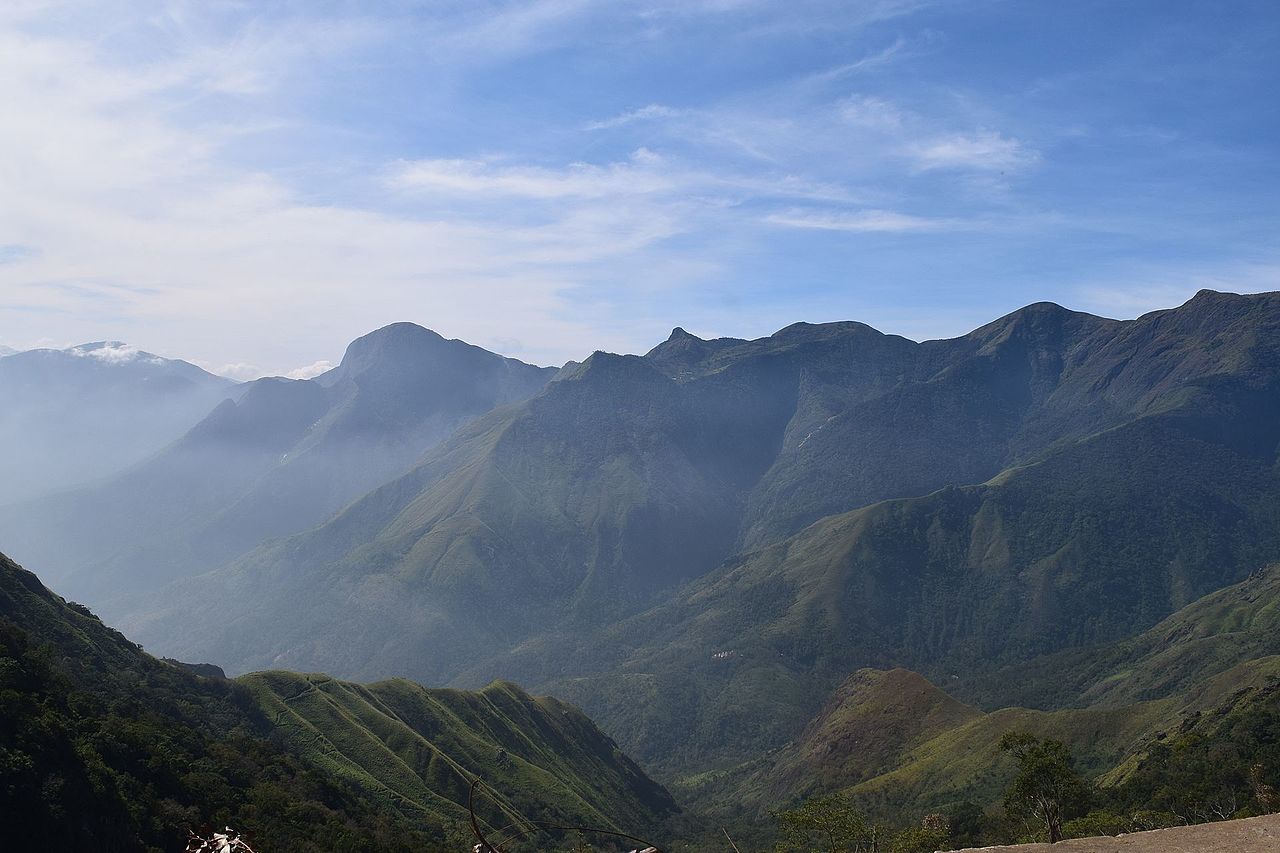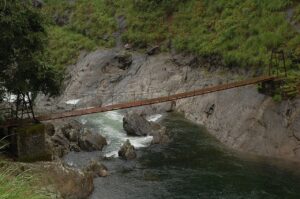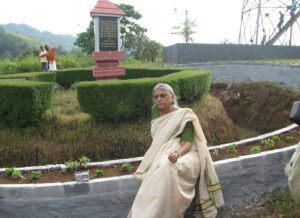The Silent Valley Movement of the 1970s in Kerala was a rare instance where public pressure, scientific advocacy, and sheer determination triumphed over the state’s developmental ambitions.
Published Apr 07, 2025 | 11:00 AM ⚊ Updated Apr 12, 2025 | 11:36 AM

Western Ghats seen from the Silent Valley National Park. (Sancia Morris/Creative Commons)
Synopsis: The battle of Hyderabad students is reminiscent of another historic environmental movement—an agitation to protect the Silent Valley in Kerala—one that took place decades before social media could amplify voices, yet still shook the corridors of power.
A storm of protests has erupted at the University of Hyderabad (UoH) as students and environmental activists rally against the Telangana government’s plan to auction 400 acres, a move they claim threatens a rare ecological treasure.
Bulldozers uprooted trees at Kancha Gachibowli, triggering outrage—not just from protesters but also from the Supreme Court, which has now stepped in to halt further destruction.
This battle is reminiscent of another historic environmental movement—one that took place decades before social media could amplify voices, yet still shook the corridors of power.
The Silent Valley Movement of the 1970s in Kerala was a rare instance where public pressure, scientific advocacy, and sheer determination triumphed over the state’s developmental ambitions.
It was not about displacement or political conflicts but a fight for nature itself.
Both movements, separated by decades and geography, share common threads that highlight the enduring power of grassroots activism, scientific reasoning, and a deep commitment to ecological preservation in India.
Silent Valley which is now a National Park, located in the Palakkad (Mannarkkad Taluk) and Malappuram (Nilambur Taluk) districts of Kerala, is one of India’s last representative tracts of virgin tropical evergreen forests.

Hanging Bridge across the Kuntipuzha River. (CJ Samson/Creative Commons)
The valley, through which the Kunthipuzha River flows at an elevation between 900 and 2,400 meters, is locally known as Sairandhrivanam.
It was originally notified as a Reserved Forest in 1914 and later designated as a National Park in 1984, covering 89.52 square kilometers under the Wildlife Protection Act, 1972.
In 2007, a 148-square-kilometer buffer zone was added to its conservation area.
Silent Valley is a critical part of the 5,500-square-kilometer core area of the Nilgiri Biosphere Reserve and an integral component of the Nilambur Elephant Reserve under Project Elephant.
It is also a part of a UNESCO World Heritage Site.
The park is renowned for its rich biodiversity, harboring 966 species of angiosperms, including 108 species of orchids, as well as 77 species of lichens and pteridophytes.
Its recorded fauna includes 41 species of mammals, 211 species of birds (including 15 Western Ghats endemics), 42 reptiles, 46 amphibians, 12 freshwater fish, 92 butterflies, and 250 moth species.
The valley is particularly famous for the endangered lion-tailed macaque (Macaca silenus).
It is said that the name “Silent Valley” was coined by the British in 1847, possibly due to the absence of noisy cicadas, while other theories suggest it originated from the Anglicization of Sairandhri or the presence of lion-tailed macaques.
The Silent Valley Plateau, situated at the southwest corner of the Nilgiris, is encircled by hills, adding to its pristine and undisturbed ecosystem.
The idea of a hydroelectric project at Kunthipuzha, impacting Silent Valley, was first mooted by the British in 1929.

Lion-tailed macaque. (NA Nazeer/Creative Commons)
Though it did not materialise then, Kerala conducted its first survey in 1951, and by the 1960s, discussions gained momentum.
In 1973, the state government proposed constructing a dam at the lower end of the valley, creating a reservoir upstream to generate 240 MW (four units of 60 MW each).
The project aimed to support industrialisation, irrigate 10,000 hectares in Palakkad and Malappuram, create 3,000 construction jobs, and boost Kerala’s economy.
With strong political backing, it received Planning Commission approval in February 1973 at an estimated ₹25 crore.
However, environmental concerns soon emerged.
In the early 1970s, scientist Steven Green raised alarms over threats to the rare lion-tailed macaque.
In 1976, the National Committee on Environmental Planning and Coordination, led by ZR Futehally, recommended scrapping the project but suggested safeguards if unavoidable.
Conservationists warned of deforestation, poaching, and habitat destruction, sparking protests led by Satish Chandran Nair, VS Vijayam, S Prabhakaran Nair, and Prof. John Jacob.
Despite mounting opposition, Kerala remained firm, attracting global attention.
Organisations like IUCN, Bombay Natural History Society, and experts like Salim Ali, Madhav Gadgil, and MS Swaminathan pushed for Silent Valley’s protection, but the then Prime Minister Morarji Desai rejected these appeals.
Though then Minister for Industries and Electricity PK Vasudevan acknowledged Silent Valley’s uniqueness, while presenting a resolution on 28 February 1978 urging the central government to approve the project, as he stated, “experts believed Silent Valley was a unique and irreplaceable ecosystem that should remain untouched as a biosphere reserve. The prime minister is having a hard time to take a decision,” the government persisted for the project.
What began as a modest protest soon turned into a nationwide environmental movement, uniting activists, artists, students, and media in a storm of resistance.
The Silent Valley movement in Kerala stands as a testament to the power of collective resistance, intellectual discourse, and creative expression in environmental activism.

Sugathakumari at Silent Valley in Palakkad. (Supplied)
As highlighted in Subhash Sharma’s Why People Protest – An Analysis of Ecological Movements, organizations like the Silent Valley Samrakshana Samiti and the Kerala Sastra Sahitya Parishad (KSSP) played a pivotal role in mobilising public support through rallies, meetings, debates, and media engagement.
Initially, most newspapers remained indifferent, except for The Express (a local daily), but as the movement gained momentum, publications like Indian Express and The Hindu began supporting the cause.
KSSP, a ‘science to people’ movement led by educators, effectively broadened the movement’s scope by engaging botanists, zoologists, and economists to expose the ecological damage the hydroelectric project would cause.
The campaign even garnered international attention, with the World Wildlife Fund (WWF) and the International Union for Conservation of Nature (IUCN) stepping in to protect the rare lion-tailed macaque.
Despite the Kerala Assembly’s unanimous resolution favoring the project, persistent scientific debates, legal interventions, and sustained media lobbying delayed its implementation.
The movement was further strengthened by poet-environmentalist Sugatha Kumari, who, along with other Malayalam writers, used literature as a tool of protest.
In the book ‘Just Between Us – Women Speak About Their Writing‘, she emphasised how poetry readings and songs resonated deeply with people, transforming the struggle into a widespread movement.
With over 400 poetry gatherings held statewide, writers emerged as foot soldiers of change, proving that literature could inspire and mobilize a successful resistance against environmental destruction.
In the interview published in the book, Sugathakumari said, “We assumed it was a losing battle, we never thought we would win. But we decided that even such battles needed foot-soldiers and began writing about the issue. There was a tremendous response from the people who read and heard us. So we were able to create change by reciting poetry and singing!.”
After years of intense public pressure, spirited campaigning, and relentless lobbying, the controversial hydroelectric project in Silent Valley was finally dropped — a landmark moment in India’s environmental history.
The turning point came with the then Prime Minister Indira Gandhi’s repeated insistence on exploring the ecological implications and seeking viable alternatives.
Responding to the groundswell of public sentiment and her own environmental concerns, the project was officially shelved in November 1983.
In a historic move, the area earmarked for the project was brought under protection, and on 15 November 1984, the Silent Valley National Park was re-notified.
A year later, Prime Minister Rajiv Gandhi formally inaugurated the park, underscoring the government’s commitment to conservation.
What made the Silent Valley movement remarkable was its unique focus — it wasn’t about displacement or rehabilitation but about preserving one of the last remaining tropical evergreen rainforests and protecting endangered species like the lion-tailed macaque.
It was a people-powered ecological awakening.
The protest at the UoH mirrors the Silent Valley Movement in Kerala, both in spirit and strategy.
At their core, these movements challenge the dominance of short-term development goals over long-term ecological sustainability.
Like the Silent Valley campaign—which opposed a hydroelectric dam project threatening a tropical rainforest—UoH students and faculty are resisting the conversion of biodiversity-rich land into an IT park, warning of irreversible environmental damage.
Both movements are rooted in scientifically informed activism: Silent Valley had the backing of ecologists like Salim Ali, while UoH protesters have presented ecological data on species diversity and the land’s role in mitigating Hyderabad’s urban heat.
The protests also reflect strong grassroots mobilisation—Silent Valley drew poets, scientists, and global voices; UoH has united students, faculty, alumni, and climate activists through digital platforms.
Both faced state resistance, including arrests and dismissals of ecological concerns.
Ultimately, these movements are bound by a moral commitment to preserve nature.
Whether in the forests of Palakkad or the scrublands of Hyderabad, they echo the same message: environmental integrity must not be sacrificed at the altar of unchecked development.
(Edited by Majnu Babu).
